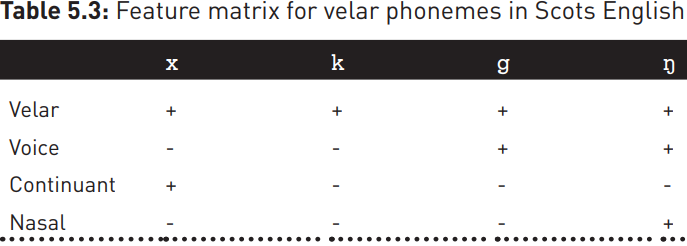
Distinctive features and natural classes
 المؤلف:
David Hornsby
المؤلف:
David Hornsby
 المصدر:
Linguistics A complete introduction
المصدر:
Linguistics A complete introduction
 الجزء والصفحة:
98-5
الجزء والصفحة:
98-5
 2023-12-16
2023-12-16
 1654
1654
Distinctive features and natural classes
In some of the examples above, we have seen that certain groups of sounds have similar properties, or tend to behave in similar ways. One set of consonants was affected, for example, by a rule involving word-final position in German, which we could identify by a series of rules:

These rules should be read as ‘/b/ becomes /p/ in the environment of a word boundary’ and so on, and we could in principle set out similar rules for all the consonants affected by the devoicing rule, but such an approach misses an obvious generalization about all these consonant pairs, namely that those to the left of the arrow are all voiced and those to the right are all voiceless. We could therefore restate the rule rather more economically in terms of a single distinctive feature ±[voice].

The sounds affected by this rule form part of the natural class of voiced consonants. We can define a natural class as a group of speech sounds which share the same specification for one or more features. Natural classes often share properties cross-linguistically. Dutch, Russian and Polish, for example, all have a word-final consonant devoicing rule, as do some French dialects. Another natural class is nasals, the feature [+nasal] being shared by  , among others. We can extend the principle further and establish feature matrices for phonemes, as for example in Table 5.3 for the velar consonants of Scots English. The feature ±[continuant] distinguishes oral and nasal stops [-continuant], for which the airflow in the vocal tract is blocked, from all other sounds, which allow continuous airflow and are therefore [+continuant]:
, among others. We can extend the principle further and establish feature matrices for phonemes, as for example in Table 5.3 for the velar consonants of Scots English. The feature ±[continuant] distinguishes oral and nasal stops [-continuant], for which the airflow in the vocal tract is blocked, from all other sounds, which allow continuous airflow and are therefore [+continuant]:

The four phonemes form part of a single class by virtue of sharing the feature specification [+velar]. Note that the specification [+voice] is redundant for  , as all nasals are voiced in English, but this feature is distinctive for /k/ and /g/. The feature ± [aspirated] is not included in our matrix because aspiration is not distinctive in English: its presence or absence in certain environments for voiceless plosives is entirely predictable and not a property of the phoneme itself, as it would be in Thai, where aspiration is phonemic.
, as all nasals are voiced in English, but this feature is distinctive for /k/ and /g/. The feature ± [aspirated] is not included in our matrix because aspiration is not distinctive in English: its presence or absence in certain environments for voiceless plosives is entirely predictable and not a property of the phoneme itself, as it would be in Thai, where aspiration is phonemic.
Attempts have been made to establish a universal feature set from which the phonemes of all the world’s languages could be defined. A first set was proposed in 1952 by Jakobson, Fant and Halle and was refined for the description of English by Chomsky and Halle in 1968. This set has since undergone a number of changes, with putatively universal features such as ±[diffuse] or ±[compact] having been largely abandoned. Some have criticized the emphasis in most feature systems on binarity: it is not entirely clear that ± features are appropriate for vowels, or that they are well equipped to deal with phonemic tone in languages such as Hokkien or Vietnamese. But there is no doubt that features have a role in identifying natural classes, and in capturing important cross-linguistic generalizations.
 الاكثر قراءة في Phonetics
الاكثر قراءة في Phonetics
 اخر الاخبار
اخر الاخبار
اخبار العتبة العباسية المقدسة


